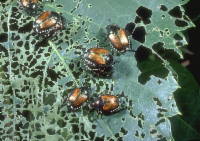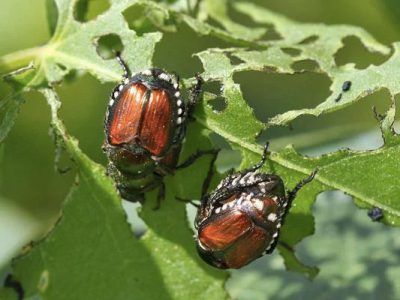by Barrie Anderson
The very sound of the words, Japanese Beetles invokes irritation, frustration and gloom among Minnesota gardeners. We can see them in our minds chewing, crawling, and decimating our Roses, our tropical Hibiscus flowers, our Grapevines and….our souls!
As we know, these beetles take no prisoners. The adults are only here in summer for roughly 40 days, yet the amount of carnage they wreak in our landscape is overwhelming. There are now more proven methods available to gardeners to duel these incorrigible insects.
There are attack and prevention methods, both when utilized appear to be moderately to highly successful in subduing and nearly eradicating the beetles. One of the more successful liquid spray methods is that of Neem Oil. This product is a naturally occurring pesticide found in the Neem tree. The seeds of the Neem tree are what actually have the highest concentration of the pesticidal compound, Azadirachin. The best part of using Neem Oil is that it only affects leaf chewing pests! Which means it will NOT HARM bees, butterflies, lady bugs and any pollinators! It’s also safe to use on edibles! It does have a strong odor similar to garlic and Sulphur, which acts as a repellant as well. To use Neem Oil, it comes already prepared and ready right off the shelf for gardeners to spray directly on the affected plants. It can also be purchased in concentrate if a gardener desires to develop their own mix. The key is to spray the Neem Oil while the plant is not in direct sunlight as this spray may slightly burn the leaves. Also, the Neem Oil will break down fairly rapidly on the leaves, within 1-2.5 days of application, so again, there’s no threat to mammals, birds, people, bees etc… It can be applied at the same time as fertilizer, in tandem. Mix 1 teaspoon of Neem Oil with 1 quart of warm water, it must be warm water as Neem blends better with warm water. Then prepare whatever fertilizer chosen and pour the Neem Oil mix in with the fertilizer and the concoction is ready to go! Particularly Roses have seemed to benefit from being sprayed with Neem Oil. The Japanese beetles ingest the oil and pass it along to the eggs. The eggs now are contaminated with the Neem Oil and are unable to fully develop into larva and thus die before ever reaching adulthood.
Another method of protecting roses is as soon as the beetles are spotted, cut off the bud blooms on roses prior to them opening up. The beetles LOVE to eat the blooms, but if they don’t have any flowers to eat, they won’t stick around. This applies to both shrub and tea roses. I have personally attempted this method and it was successful. I chopped off the buds on my roses for the 6 week duration of the beetle infestation, and once the beetles had fled, I was able to spare the buds on the roses and I still had some sensational blooms for the remainder of the season!
One mode NOT to employ in this crusade is that of hanging Japanese beetle traps. These are bags shaped like an hourglass laced with a pheromone that attracts the beetles. They cannot resist the scent, fly into the bag and are stuck in the base unable to climb out. However, because of the pheromone attractant, more and more Japanese Beetles will descend upon the landscape and massacre whatever flora they crave. Do not hang Japanese beetle trap bags, the landscape will be annihilated and the gardener forlorn.
Another strategy for war on these insects is Milky Spore Powder. This is used on the lawn, in the garden and kills the grubs of Japanese Beetles. It is a bacteria, Bacillus popilliae, which has been around for decades and is used solely for the eradication of Japanese beetle grubs. Once the grubs have ingested the spore, the spores multiply inside the grub causing them to perish, and upon their death, release even more spores to affect more grubs! After the infestation has dissipated, the Bacillus popilliae lies dormant waiting for another scourge of beetle larvae, hence, making it a silent, durable weapon! The method of application for this powder is to put it down in autumn when the Japanese beetle grubs are feeding and the soil temperature is still quite warm, approximately 65 degrees. It is best applied from a long cardboard tube. This way there is no powder lost to wind. Dispense the powder every 4 feet in a grid pattern to the area of lawn or garden where you have noticed grub action. It will be apparent in the lawn of the grubs’ existence. There will be sections of grass that are turning yellow and then brown, and this will appear in late summer or early fall. It’s critical to water in the powder within 24 hours after applying. The grubs need time to ingest the spores, so results may not be noticed for several months or even a season or two. However, the bonus to using the Milky Spore Powder is once it’s been utilized in the landscape it lasts for a minimum of 10 years without another application! It’s also eco friendly in that it will not harm earthworms, people, dogs, birds or bees! I too have exercised Milky Spore Powder in my landscape and noticed a staggering reduction in Japanese beetles in my garden, as did my neighbors in their gardens as well. Coincidence? Perhaps, but if it worked once, chances are it’s worth noting and documenting the level of infestation for the next few seasons.
Prevention mode is another ploy gardeners can use against Japanese beetles. Since these feisty feeders enjoy pillaging the scenery, the next best thing growers can do is install plants the beetles won’t eat.
Some of those plants include the following:
PERENNIALS
| Plant Name | Sun | Shade | Part Sun |
| Asters | YES | NO | NO |
| Buxus | YES | YES | YES |
| Carex grasses | NO | NO | YES |
| Cimicifuga | NO | YES | NO |
| Euonymous | YES | NO | YES |
| Hosta | NO | YES | NO |
| Magnolia | YES | NO | NO |
| Miscanthus sinensis | YES | NO | YES |
| Pachysandra | NO | YES | YES |
| Perovskia | YES | NO | YES |
ANNUALS
| Plant name | Sun | Shade | Part Sun |
| Alyssum | YES | NO | YES |
| Angel Wing Begonia | YES | YES | YES |
| Dragon Wing Begonia | YES | YES | YES |
| Begonia boliviensis (Firecracker Begonia) | YES | NO | YES |
| Cuphea hysopfilia (Mexican Heather) | YES | NO | YES |
| Cuphea ignea (Cigar Plant) | YES | NO | YES |
| Euphorbia | YES | YES | YES |
| Fibrous Begonia | YES | YES | YES |
| Helichrysum | YES | NO | YES |
| Heliotrope | YES | NO | YES |
| Impatiens (Double, New Guinea, Single) | NO | YES | YES |
To successfully combat the Japanese beetles, it’s a fantastic idea to implement all of the above techniques. Maintain consistency with whatever approach is chosen and the crusade win be in the favor of the gardener!
For more advice like this, visit our Blog Page. If you are looking into gardening services around Minnetonka, Wayzata, Excelsior, or related areas, Contact Us Today!


